Study on the Optimization of Investment Casting Process of Exhaust Elbow for High-Power Engine
Abstract
:1. Introduction
2. Program Design
2.1. Structural Design of Exhaust Elbow Casting
2.2. Exhaust Elbow Materials
2.3. Pouring System Design
3. Casting Process Simulation
3.1. Analysis of the Simulation Results of the Filling Process
3.2. Analysis of Simulation Results of Solidification Process
3.3. Location Distribution of Casting Defects
3.4. Programme Optimization
3.4.1. Optimization of Casting Parameters
3.4.2. Simulation of Optimal Casting Solutions
4. Casting Trial Production and Process Inspection
4.1. Preparation and Production for Investment Casting
4.2. Quality Verification of Exhaust Pipe Castings
4.2.1. Exterior Inspection of Exhaust Elbows
4.2.2. Internal Quality Inspection of Exhaust Pipe Castings
5. Conclusions
- Determine the optimal process parameters: pouring temperature of 1650 °C, pouring speed of 1.5 kg/s, and shell preheating temperature of 1050 °C.
- Analysis of individual process parameter changes on the casting of the internal size of the volume of shrinkage: it is indicated that an increase in the preheating temperature of the mold will significantly slow down the cooling and solidification rate of the alloy liquid, thereby reducing the likelihood of shrinkage defects occurring.
- The process flow was summarized and analyzed, along with the castings manufactured before and after parameter optimization. Dimensional testing, visual inspection, and industrial CT testing were conducted to demonstrate that optimization can effectively produce castings with high internal quality, surface quality, and dimensional accuracy to achieve the desired outcomes for whole casting forming.
- The research resulted in a reduction in material and labor costs associated with machining and welding, while significantly improving product pass rates.
- The casting system has some limitations: its structure is complex, there are many redundant parts, the casting requirements are high, and maintaining a high pass rate is difficult. Future research can enhance the pouring system to decrease production costs and complexity, consequently boosting the product qualification rate.
Author Contributions
Funding
Data Availability Statement
Conflicts of Interest
References
- Mendes, A.; Tomoyose, R. Exhaust Manifold Structural Analysis Focusing Mass Reduction for Vehicular Diesel Engine Application; SAE International: Warrendale, PA, USA, 2010. [Google Scholar] [CrossRef]
- Meda, L.; Shu, Y.; Romzek, M. Exhaust System Manifold Development; SAE Technical Paper 2012-01-0643; SAE International: Warrendale, PA, USA, 2012; p. 10. [Google Scholar] [CrossRef]
- Guo, S.C.; Zhu, Y.; Chen, D.; Gao, X.R.; Cheng, T.; Lin, Z.H. Numerical simulation of the flow performance of a diesel engine exhaust system and its structural optimization. Chin. Intern. Combust. Engine Eng. 2017, 38, 113–119. [Google Scholar]
- Galindo, J.; Luján, J.M.; Serrano, J.R.; Dolz, V.; Guilain, S. Design of an exhaust manifold to improve transient performance of a high-speed turbocharged diesel engine. Exp. Therm. Fluid Sci. 2004, 28, 863–875. [Google Scholar] [CrossRef]
- Lorenzini, M.; Barbieri, S.G.; Mangeruga, V.; Giacopini, M. Development of an experimental/numerical validation methodology for the design of exhaust manifolds of high performance internal combustion engines. Eng. Fail. Anal. 2023, 152, 1350–6307. [Google Scholar]
- Xu, Y.; Huang, S.; Su, L.; Zhang, X.; Li, Y. Elbow flow analysis and optimal exhaust port profile design. J. Mech. Sci. Technol. 2022, 2, 1251–1262. [Google Scholar] [CrossRef]
- Liu, F.; Xu, Y.; Rui, J.; Shi, Z.; Li, Y. Flow Analysis and Theoretical Design of Diesel Engine Exhaust Port. Int. J. Automot. Technol. 2020, 21, 189–196. [Google Scholar] [CrossRef]
- Bohac, S.; Landfahrer, K. Effects of pulsating flow on exhaust port flow coefficients. SAE Int. J. Engines 1999, 108, 299–309. [Google Scholar]
- Zu, B.F.; Kang, X.L.; Fu, G.Q.; Xu, Y.L.; Liu, J. Structural design and estimation on intake and exhaust ports of multi-valve engines. Trans. Chin. Soc. Agric. Mach. 2005, 36, 28–35. [Google Scholar]
- Pattnaik, S.; Karunakar, D.B.; Jha, P.K. Developments in investment casting process—A review. J. Mater. Process Technol. 2012, 212, 2332–2348. [Google Scholar] [CrossRef]
- China Foundry Association. Investment Casting Manual; China Machine Press: Beijing, China, 2000. [Google Scholar]
- Morsiya, C.V.; Pandya, S.N. Recent Advancements in Hybrid Investment Casting Process—A Review. In Proceedings of the 2nd International Conference on Recent Advances in Manufacturing (RAM 2021), Surat, India, 10–12 June 2021; pp. 817–831. [Google Scholar] [CrossRef]
- Dave, H.K.; Dixit, U.S.; Nedelcu, D. Lecture Notes in Mechanical Engineering; Springer: Singapore, 2022; pp. 817–831. [Google Scholar]
- Santos, E.C.; Shiomi, M.; Osakada, K.; Laoui, T. Rapid manufacturing of metal components by laser forming. Int. J. Mach. Tools Manuf. 2006, 46, 1459–1468. [Google Scholar] [CrossRef]
- Yuli, S.; Sungging, P. Investment Casting Simulation of ASTM F75 Acetabular Implant with Mold Pattern Orientation and Gating System Geometry Variation. Appl. Mech. Mater. 2024, 7052, 157–168. [Google Scholar]
- Kumar, P.; Singh, R.; Ahuja, I.P.S. Investigations on dimensional accuracy of the components prepared by hybrid investment casting. J. Manuf. Process 2015, 20, 525–533. [Google Scholar] [CrossRef]
- Pradhan, S.R.; Singh, R.; Banwait, S.S. Comparison of DMLS and DMLS-waste assisted investment casting. Mater. Lett. 2022, 324, 132782. [Google Scholar] [CrossRef]
- Prakash, C.; Singh, S.; Mohan, V. Comparative job production based life cycle assessment of conventional and additive manufacturing assisted investment casting of aluminium: A case study. J. Clean. Prod. 2021, 289, 125164. [Google Scholar] [CrossRef]
- Zhou, L.; Wang, D.; Cui, J.; Zhao, D.; Liu, S.; Shuai, S.; Yin, Y.; Shu, D. Modeling and experimental study on deformation prediction of thin-walled turbine blades during investment casting process. Proc. Inst. Mech. Eng. Part B J. Eng. Manuf. 2024, 238, 223–234. [Google Scholar] [CrossRef]
- Dejene, N.; Lemu, H.; Gutema, E. Critical Review of Comparative Study of Selective Laser Melting and Investment Casting for Thin-Walled Parts. Materials 2023, 16, 7346. [Google Scholar] [CrossRef] [PubMed]
- Brotzu, A.; Felli, F.; Mondal, A.; Pilone, D. Production issues in the manufacturing of TiAl turbine blades by investment casting. Procedia Struct. Integr. 2020, 25, 79–87. [Google Scholar] [CrossRef]
- Cheah, C.M.; Chua, C.K.; Lee, C.W.; Feng, C.; Totong, K. Rapid prototyping and tooling techniques: A review of applications for rapid investment casting. Int. J. Adv. Manuf. Technol. 2005, 25, 308–320. [Google Scholar] [CrossRef]
- Vaghela, J.; Valaki, J.; Thanki, S.; Pandey, A. Sustainability Analysis of Rapid Tooling-Based Investment Casting: A Comprehensive Review. Smart Sustain. Manuf. Syst. 2023, 7, 54. [Google Scholar] [CrossRef]
- Jones, S.; Yuan, C. Advances in shell moulding for investment casting. J. Mater. Process Technol. 2003, 135, 258–265. [Google Scholar] [CrossRef]
- Beeley, P.R.; Smart, R.F. Investment Casting; CRC Press: Boca Raton, FL, USA, 2023. [Google Scholar]
- Singh, S.; Kumar, R.; Kumar, R. Aluminum metal composites primed by fused deposition modeling-assisted investment casting: Hardness, surface, wear, and dimensional properties. Proc. Inst. Mech. Eng. Part L J. Mater. Des. Appl. 2022, 236, 674–691. [Google Scholar] [CrossRef]
- Kumar, P.; Ahuja, I.; Singh, R. Effect of process parameters on surface roughness of hybrid investment casting. Prog. Addit. Manuf. 2016, 1, 45. [Google Scholar] [CrossRef]
- Tewo, R.K.; Rutto, H.L.; Focke, W.; Seodigeng, T.; Koech, L.K. Formulations, development and characterization techniques of investment casting patterns. Rev. Chem. Eng. 2019, 35, 335–349. [Google Scholar] [CrossRef]
- Kumar, P.; Ahuja, I.S.; Singh, R. Experimental investigations on hardness of the biomedical implants prepared by hybrid investment casting. J. Manuf. Process 2016, 21, 160–171. [Google Scholar] [CrossRef]
- GB/T 4238-2015; Heat-Resisting Steel Plate, Sheet and Strip. China ISC S38240. Standardization Administration of China: Beijing, China, 2015.
- Liao, Q.; Ge, P.; Lu, G.; Song, Y.; Ye, W.; Gao, J.; Luo, X. Simulation Study on the Investment Casting Process of a Low-Cost Titanium Alloy Gearbox based on ProCAST. Adv. Mater. Sci. Eng. 2022, 2022, 4484762. [Google Scholar] [CrossRef]
- Zhang, X.; Li, S.; Lu, H. Simulation of Ni3Al-based Alloy and Investment Casting Process of its Thin Wall Castings. Isr. J. Chem. 2010, 47, 363–368. [Google Scholar] [CrossRef]
- Miao, L.; Tang, Z.; Zhang, D. Investment Casting Simulation and Analysis of Shell AlSi11 Alloy Part Journal. J. Phys. Conf. Ser. 2021, 2002, 12–40. [Google Scholar] [CrossRef]
- Gebelin, J.-C.; Jolly, M.R. Modelling of the investment casting process. J. Mater. Process Technol. 2003, 135, 291–300. [Google Scholar] [CrossRef]
- Yarlagadda, P.K.D.V.; Hock, T.S. Statistical analysis on accuracy of wax patterns used in investment casting process. J. Mater. Process Technol. 2003, 138, 75–81. [Google Scholar] [CrossRef]
- Silva, W.; Lopes, R.; Zscherpel, U.; Meinel, D.; Ewert, U. X-ray imaging techniques for inspection of composite pipelines. Micron 2021, 145, 103033. [Google Scholar] [CrossRef]
- GB/T 29070-2012; Non-Destructive Testing—Industrial Computed Tomography (CT) Testing—General Requirements. China ISC 19.100. Standardization Administration of China: Beijing, China, 2012.

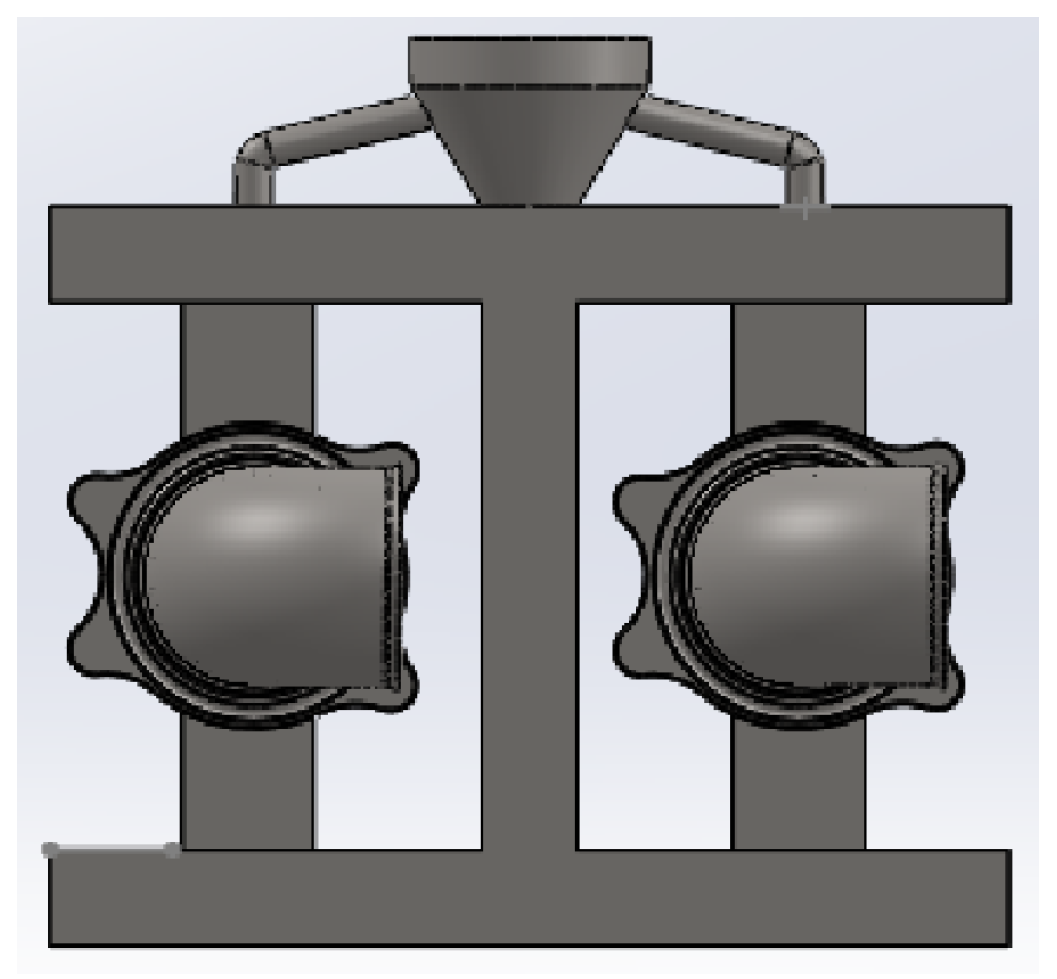
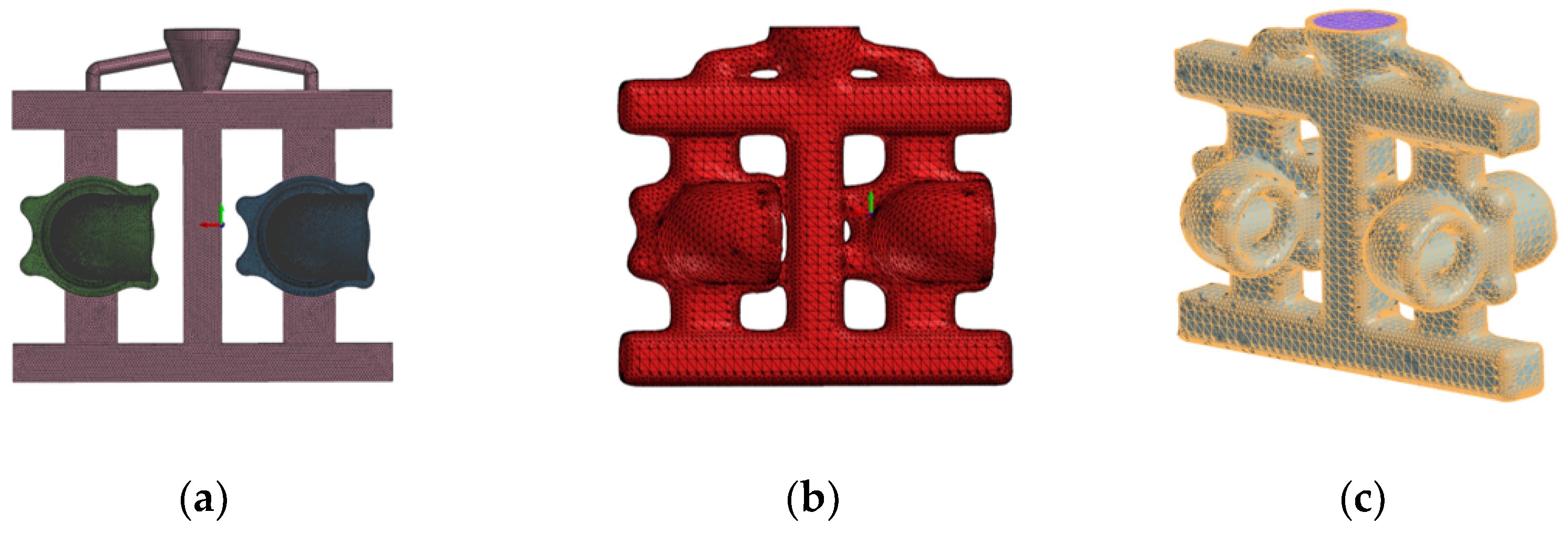


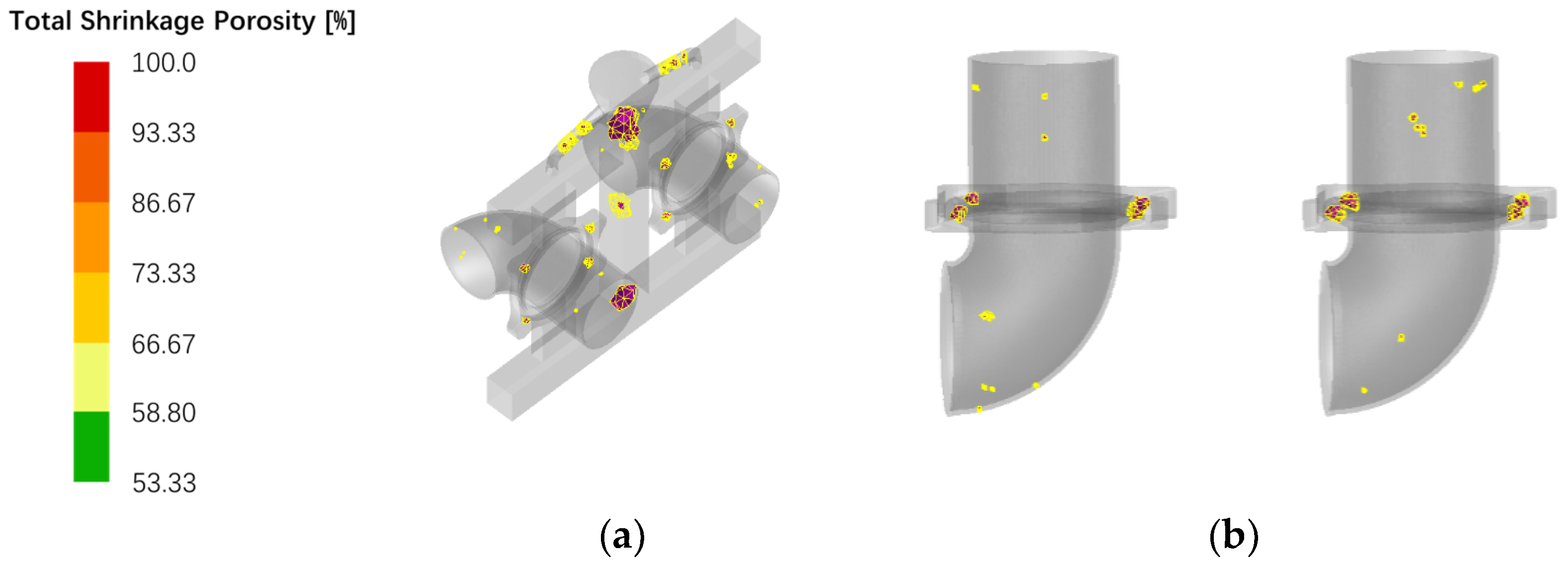

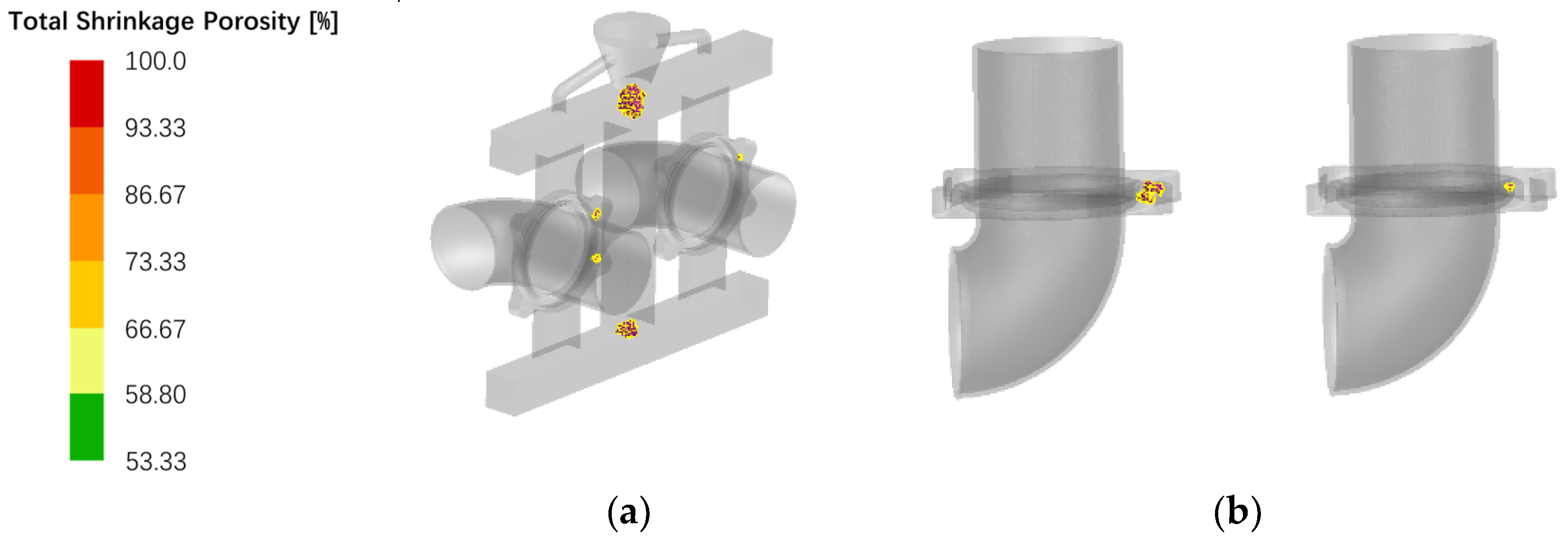


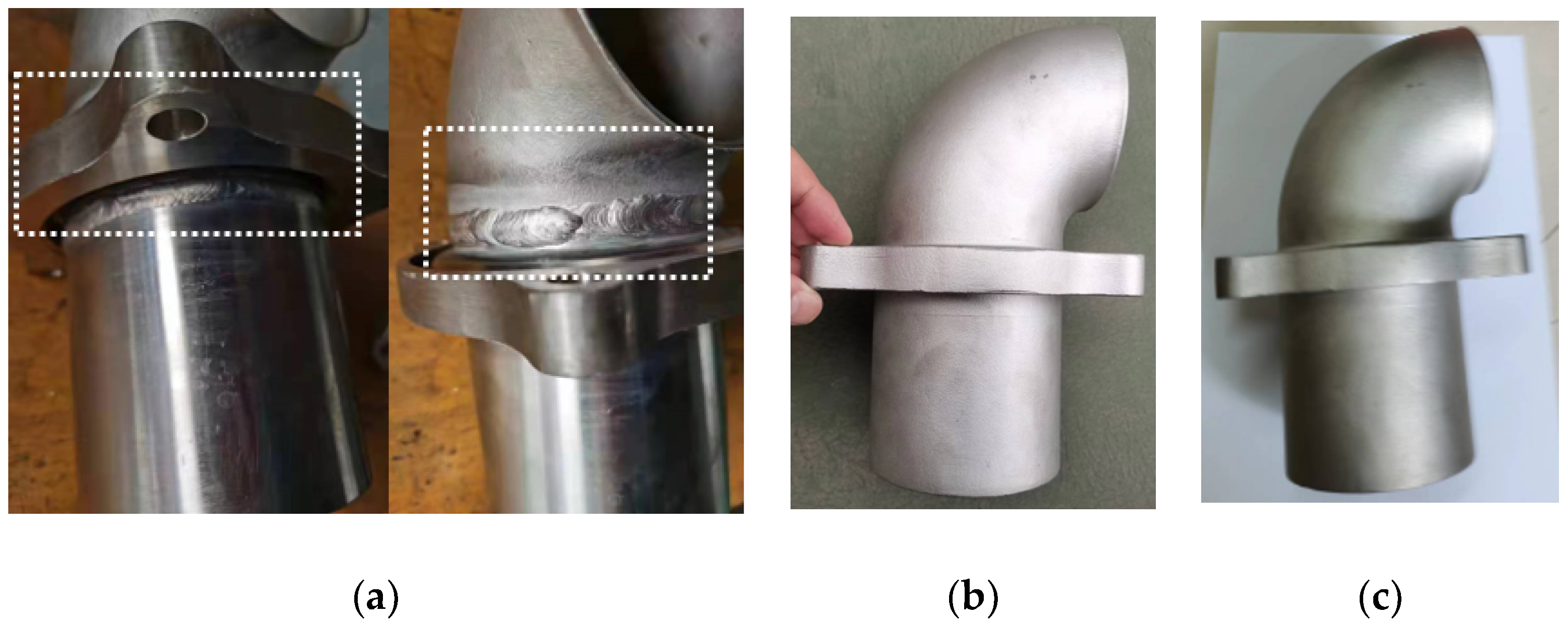


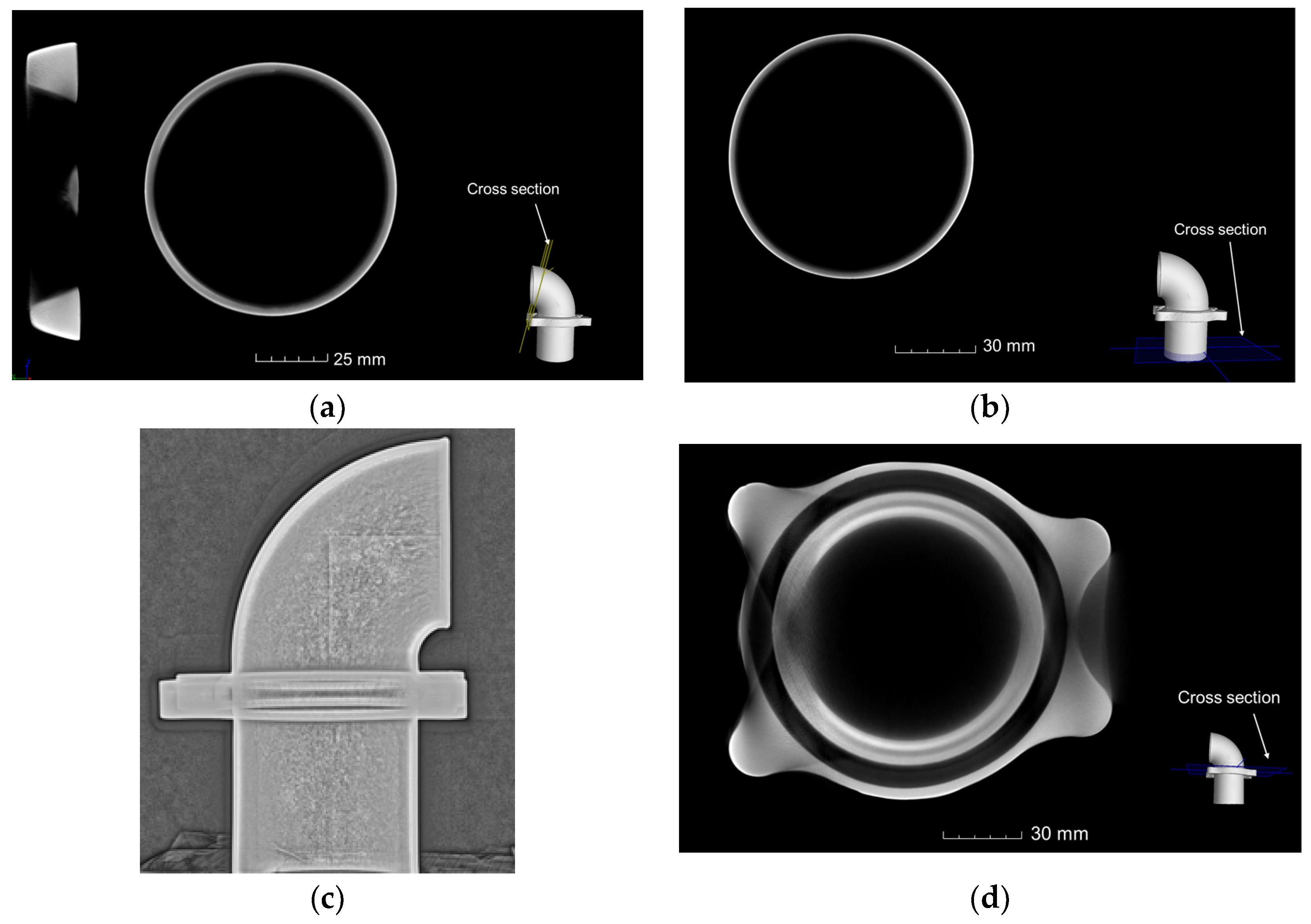
| Elemental | C | Cr | Ni | Si | Mn | P | S | Fe |
|---|---|---|---|---|---|---|---|---|
| Standard Range Value | ≤0.2 | 19–22 | 12–15 | 1.5–2.5 | ≤1.5 | ≤0.035 | ≤0.03 | Remainder |
| Actual Value | 0.0629 | 21.66 | 12.44 | 1.7 | 1.02 | 0.0296 | 0.0055 | Remainder |
| Pouring Temperature (°C) | Crude Volume (cc) | HTI (Region A) | HTI (Region B) | Effective Stress A (Mpa) | Effective Stress B (Mpa) |
|---|---|---|---|---|---|
| 1530 | 2.75 | 0.000190 | 0.000837 | 416 | 264.9 |
| 1550 | 2.12 | 0.000240 | 0.000751 | 435.7 | 275.6 |
| 1570 | 2.54 | 0.000441 | 0.000640 | 447.8 | 276.9 |
| 1590 | 1.73 | 0.000495 | 0.000554 | 454.6 | 283.6 |
| 1610 | 1.97 | 0.000270 | 0.000608 | 371.5 | 265.6 |
| 1630 | 1.49 | 0.000398 | 0.000543 | 477.1 | 337.8 |
| 1650 | 1.45 | 0.000339 | 0.000486 | 379.4 | 272 |
| Pouring Temperature (°C) | Shell Preheating Temperature (°C) | Pouring Speed (kg/s) | Crude Volume (cc) |
|---|---|---|---|
| 1550 | 800 | 1.5 | 1.77 |
| 2.0 | 1.93 | ||
| 2.5 | 2.37 | ||
| 3.0 | 2.12 | ||
| 3.5 | 3.42 | ||
| 4.0 | 3.51 | ||
| 4.5 | 3.91 |
| Pouring Temperature (°C) | Pouring Speed (kg/s) | Shell Preheating Temperature (°C) | Crude Volume (cc) |
|---|---|---|---|
| 1550 | 3 | 750 | 1.77 |
| 800 | 1.93 | ||
| 850 | 2.37 | ||
| 900 | 2.12 | ||
| 950 | 3.42 | ||
| 1000 | 3.51 | ||
| 1050 | 3.91 |
| Storey | Slurry Composition | Stickiness | Type of Sanding | Grits | Drying Time (H) |
|---|---|---|---|---|---|
| Top layer | Zirconium Powder Silica Sol | 40 ± 5 s | Zircon Sand | 120 | 15 |
| Second layer | Mullite Powder Silica Sol | 35 ± 5 s | Mullite Sand | 60 | 24 |
| Third layer | Mullite Powder Silica Sol | 25 ± 2 s | Mullite Sand | 30 | 24 |
| Fourth layer | Mullite Powder Silica Sol | 20 ± 2 s | Mullite Sand | 30 | 24 |
| Seal coat | Mullite Powder Silica Sol | 12 ± 1 s | - | - | 24 |
| Dimensions | Required Size (mm) | Maximum Deviation Detection Value | Number of Tests (Pieces) | Test Results |
|---|---|---|---|---|
| Straight tube inner diameter | 10 | Qualified | ||
| Outer diameter of straight tube | 10 | Qualified | ||
| Flange thickness (plus allowance) | 22 | 10 | Qualified | |
| Ring groove size | 10 | Qualified | ||
| Flange outer diameter | 10 | Qualified | ||
| Elbow Size | 10 | Qualified | ||
| Wall thickness of exhaust pipe | 2 | 2 | 10 | Qualified |
| Exhaust elbow centre distance | 10 | Qualified | ||
| Straight pipe + flange length | 99.5 | 10 | Qualified |
Disclaimer/Publisher’s Note: The statements, opinions and data contained in all publications are solely those of the individual author(s) and contributor(s) and not of MDPI and/or the editor(s). MDPI and/or the editor(s) disclaim responsibility for any injury to people or property resulting from any ideas, methods, instructions or products referred to in the content. |
© 2024 by the authors. Licensee MDPI, Basel, Switzerland. This article is an open access article distributed under the terms and conditions of the Creative Commons Attribution (CC BY) license (https://creativecommons.org/licenses/by/4.0/).
Share and Cite
Xie, S.; Lv, Z.; Dong, S. Study on the Optimization of Investment Casting Process of Exhaust Elbow for High-Power Engine. Metals 2024, 14, 481. https://doi.org/10.3390/met14040481
Xie S, Lv Z, Dong S. Study on the Optimization of Investment Casting Process of Exhaust Elbow for High-Power Engine. Metals. 2024; 14(4):481. https://doi.org/10.3390/met14040481
Chicago/Turabian StyleXie, Shiyu, Zhaozhao Lv, and Shengquan Dong. 2024. "Study on the Optimization of Investment Casting Process of Exhaust Elbow for High-Power Engine" Metals 14, no. 4: 481. https://doi.org/10.3390/met14040481






